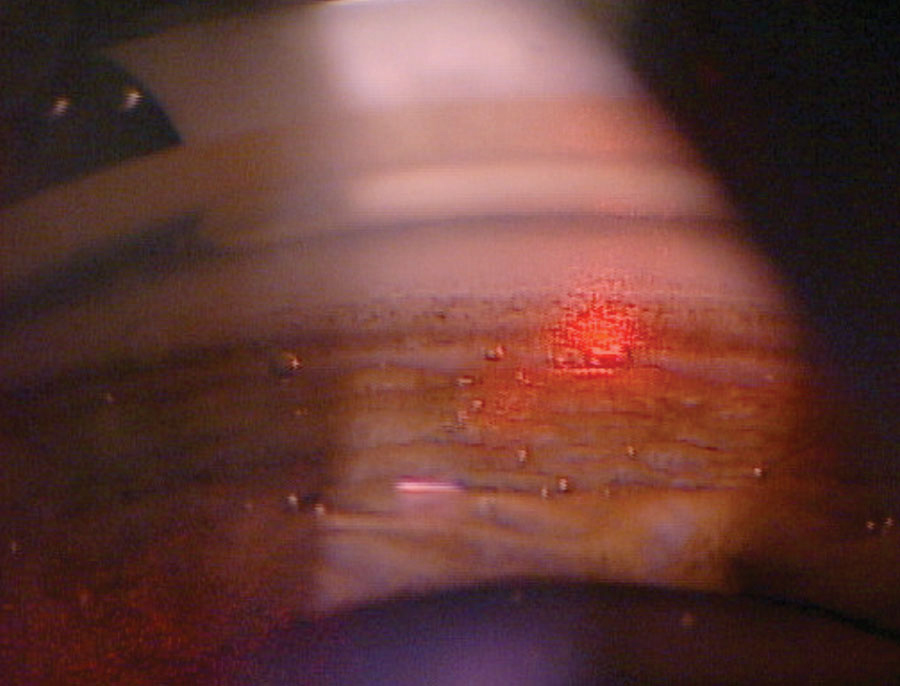 |
|
Most cases of OAG and ocular hypertension were highly responsive to SLT and support the consideration of repeat SLT regardless of initial response. Participants who were older, female, had lower baseline IOP or had moderate or severe visual field loss experienced worse outcomes. Photo: Nate Lighthizer, OD. Click image to enlarge. |
Selective laser trabeculoplasty (SLT) is becoming the recommended first choice in the treatment of open-angle glaucoma (OAG). Whether repeat treatments are appropriate for patients with a poor initial response remains controversial, but resolving the controversy is crucial for refining an understanding of its applicability. In a recent study published in JAMA Ophthalmology, researchers conducted a post-hoc analysis of the Laser in Glaucoma and Ocular Hypertension Trial in China (LiGHT China) to determine that, when using repeat SLT as the first choice of treatment escalation regardless of the initial response, the repeated treatment was associated with similar IOP control to the initial laser with a longer duration of effect.1
Of the 1,376 newly diagnosed OAG and ocular hypertensive eyes of 771 adults in the original trial, 180 eyes of 105 participants (mean age, 45.6 years; 55.2% male) were included in the present study, who underwent initial and repeat SLT as primary treatments. IOP reduction after SLT and the duration of effect were analyzed. The maximum reduction in IOP within two years after initial SLT and repeat SLT was used to identify potential unresponsiveness.
Initial SLT and repeat SLT were both associated with a reduction in IOP (mean, 4.5mm Hg and mean, 3.3mm Hg, respectively). The mean IOP after repeat SLT was 15.8mm Hg, similar to 16.0mm Hg after initial SLT (difference, -0.4mm Hg). Duration of effect after repeat SLT was longer than after initial SLT (1,043 days vs. 419 days; hazard ratio: 0.38). IOP reduction after initial SLT was uncorrelated with that after repeat SLT, and 85.0% of eyes responded favorably to SLT at least once. A subset of 15.0% eyes was identified as potentially nonresponsive and found distinctive with older age (mean, 54.1 years vs. 44.2 years; difference, 10.5 years), a higher proportion of female participants (difference, 27.5%) and a lower baseline IOP (difference, -3.2mm Hg).
“We demonstrated that IOP reduction observed from only one SLT intervention, especially at an isolated time mark, was not predictive of the effectiveness of repeat SLT. This is likely because various uncertain factors can influence the actual effect, and IOP at an isolated time mark should not be considered representative,” the researchers wrote in their paper. “Most participants had the potential to acquire a considerable reduction in IOP even if they did not achieve reduction initially.”1
A commentary also published in JAMA Ophthalmology found it reassuring that the LiGHT Study in China had comparable outcomes to the LiGHT United Kingdom Study. However, the authors took issue with the study’s outcome for repeat SLT was not analyzed as the achievement of individual target IOP, but rather as the “IOP recorded at two months after both initial and repeat SLT was primarily concerned in the analysis.”2
“While a two-month outcome captures immediate failure, it does not signify even medium-term success,” the authors wrote in their commentary. “The authors further report that ‘To better clarify the responsiveness to SLT, the maximum reduction in IOP within two years after SLT was explored. A poor response to SLT was defined if the maximum reduction in IOP was less than 20% during the follow-up.’ This is equivalent to allowing the best IOP to be the result, rather than consistent achievement of the selected target IOP.”
The commentary noted that decades of clinical experience with SLT have demonstrated its low risk and ability to lower IOP in many people. However, there is often a continued need for adjunctive eye drop medication as the effect of SLT wears off. It emphasized that, with angle-based glaucoma surgeries becoming widely used, the potential negative impact of past SLT on these surgeries’ efficacy is another question that needs to be studied.2
1. Yang Y, Xu K, Chen Z, et al. Responsiveness to selective laser trabeculoplasty in open-angle glaucoma and ocular hypertension. JAMA Ophthalmol. August 22, 2024. [Epub ahead of print]. 2. Kanter JA, Quigley HA. Repeat selective laser trabeculoplasty and open-angle glaucoma. JAMA Ophthalmol. August 22, 2024. [Epub ahead of print]. |


